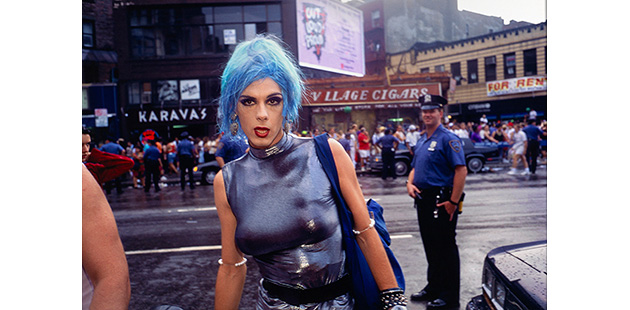 Opening in late 2021, Queer is a landmark, Australian-first exhibition that will explore the NGV Collection through a queer lens and celebrate the rich, diverse and sometimes untold stories that emerge.
Opening in late 2021, Queer is a landmark, Australian-first exhibition that will explore the NGV Collection through a queer lens and celebrate the rich, diverse and sometimes untold stories that emerge.
Spanning five gallery spaces and featuring more than 300 artworks across historical eras and cultures, the exhibition will be the most comprehensive thematic presentation of artworks relating to queer stories ever mounted in an Australian art institution.
Bringing together a breadth of artworks from antiquity to the present day, the exhibition will illuminate the ways in which queer lives and stories have been expressed in art through history.
Drawing on contemporary research, interpretation and analysis, the exhibition will also explore the narratives that might not have been visible in the past due to suppression, prejudice or discrimination.
The exhibition will be curated across more than ten thematic sections and include painting, drawing, photography, decorative arts, fashion, textiles, video, sculpture, design and architecture. Highlight works include:
- Leigh Bowery’s subversive and boundary-pushing fashion ‘looks’, including The Metropolitan (c. 1988) in which a full-length floral satin dress is paired with a face covering, a black ‘Kaiser’ helmet and a pair of camouflage print leather gloves;
- Ponch Hawkes’s 1973 photograph, No title (Two women embracing, ‘Glad to be gay’), which depicts a couple proudly and courageously celebrating their love during the Gay Liberation Movement in Melbourne;
- Albrecht Dürer, St Sebastian at the tree, 1501, which depicts the early Christian martyr who since the Renaissance has been often portrayed as a beautiful young man, giving rise to homoerotic interpretations of his story. By the late 19th century, Sebastian had emerged as a queer icon, beloved by Oscar Wilde who, in French exile after his trial, took the alias ‘Sebastian Melmoth’;
- Brassaï’s photograph Le Monocle, the bar. On the left is Lulu de Montparnasse, which captures the defiant lesbian and gender non-conforming patrons of Le Monocle, a prominent lesbian bar active during the interwar years in Paris;
- A Greek Chalkidian black-figure vase, 540 BCE, depicting Achilles, the Greek hero of the Trojan War, who was said by ancient authors such as Aeschylus and Plato to have taken his warrior friend Patroklus as his lover;
- Brook Andrew’s S & D II, 1997, in which issues of queer identity, sexuality and mythmaking are explored through the superimposition of Chinese characters for “solid” and “robust” onto a photograph of a bare-chested Wiradjuri man, emphasizing the subject’s sexuality and musculature;
- Peter Behrens’ The kiss, 1898, noted for the androgynous kissing couple at the centre of its Art Nouveau composition, illuminating gender ambiguity and fluidity of the late 19th century;
- Destiny Deacon’s Where’s Mickey? – a photograph that unsettles the binary distinctions that have shaped western culture and its constructions of race and gender by presenting Torres Strait Islander man Luke Captain dressed as a drag version of the iconic cartoon mouse;
- The watercolour Shiva in the form of Ardhanarisvara (c. 1980) by Maithil, which illustrates an androgynous Hindu deity formed by the union of the male god Shiva with the goddess Parvati, suggesting that the supreme being is neither one sex nor the other, but a fusion of both;
- Agnes Goodsir’s subtle and engaging portrait, The letter, 1926, which features the artist’s muse, lover and partner of almost 30 years, Rachel Dunn, known to her friends as ‘Cherry’; and
- A 1654 engraving of the 17th century monarch Queen Christina of Sweden, who, like numerous European royals protected by their wealth and status, subverted the sexual mores of the time by refusing to marry and sharing close relationships with a number of women.
The artworks in the exhibition reflect the multifaceted meaning and usage of the word ‘queer’: as an expression of sexuality and gender, as a philosophy, as a political movement, as a sensibility, as an attitude that defies fixed definition, as well as the impossibility of a single term to capture the multitude of lived experiences.
Many of the artworks included in the exhibition are by artists who identify as queer; some are by artists who lived in times when such identification was not possible; and some works are not by a queer artist but have a connection to queer histories.
The exhibition will also identify and negotiate absences in the NGV Collection, by excavating queer history where it has been omitted or eclipsed, through oversight or through intent. In this way, rather than attempting to present a comprehensive history of queer art, the exhibition will reflect on the gaps, strengths and idiosyncrasies of the NGV Collection, as well as broader concerns around collecting and exhibiting art works relating to queer ideas and identities in museum contexts.
“Never has a queer thematic exhibition of this scale and nuance been staged in an Australian art institution,” said Tony Ellwood AM, Director NGV. “Queer shines a light on the NGV Collection to examine and reveal the queer stories that the artworks have to tell.”
“Drawing on a broad selection of beloved and lesser-known artworks, this exhibition will present audiences with the opportunity to interpret queer concepts and stories in surprising and thought-provoking ways,” he said.
In keeping with the breadth and complexity of its subject, Queer is being curated by an interdepartmental curatorial team including: Dr Ted Gott, Senior Curator of International Art; Dr Angela Hesson, Curator of Australian Art; Myles Russell-Cook, Curator of Indigenous Art; Meg Slater, Assistant Curator of International Exhibition Projects; and Pip Wallis, Curator of Contemporary Art.
Queer
NGV International, St Kilda Road, Melbourne
Exhibition: 10 December 2021 – June 2022
Free entry
For more information, visit: www.ngv.melbourne for details.
Image: Nan Goldin, Misty in Sheridan Square, NYC , 1991. cibachrome photograph. National Gallery of Victoria, Melbourne. Purchased NGV Foundation, 2015. © Nan Goldin, courtesy Matthew Marks Gallery
